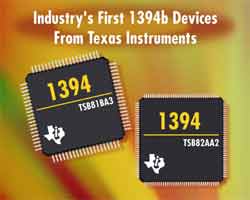Related Documentation:
> Interface Products
> News Releases
publications
> Technology Innovations
> Sine On Analog and Mixed-
Signal Catalog
trade shows
> Current Trade Shows
search news archives
> Search the News Archives
|
|
TI Unveils Industry's First 1394b High Performance Serial Bus Devices for Mass Storage, Consumer Electronics and Automotive Applications
Higher speeds and extended distances open new applications for the 1394 High Performance Serial Bus (Firewire, i.Link)
 INTEL DEVELOPER FORUM, SAN JOSE, Calif., (Aug., 27, 2001) -- Two new devices from Texas Instruments (TI) Incorporated (NYSE: TXN) forming the first devices compliant with the latest version of the IEEE 1394b specification are being demonstrated this week at the Intel Developers Forum in San Jose, CA (Booth #623). The first instantiation of IEEE 1394b not only doubles the speed of the previous generation of IEEE 1394 devices to 800 megabits-per-second (Mbps), it also increases distances up to 100 meters. These enhanced features allow designers of PCs, mass storage, consumer electronics and automotive applications to increase the functionality of designs while simplifying architecture and reducing costs. (See http://www.ti.com/sc/msp6743u).
INTEL DEVELOPER FORUM, SAN JOSE, Calif., (Aug., 27, 2001) -- Two new devices from Texas Instruments (TI) Incorporated (NYSE: TXN) forming the first devices compliant with the latest version of the IEEE 1394b specification are being demonstrated this week at the Intel Developers Forum in San Jose, CA (Booth #623). The first instantiation of IEEE 1394b not only doubles the speed of the previous generation of IEEE 1394 devices to 800 megabits-per-second (Mbps), it also increases distances up to 100 meters. These enhanced features allow designers of PCs, mass storage, consumer electronics and automotive applications to increase the functionality of designs while simplifying architecture and reducing costs. (See http://www.ti.com/sc/msp6743u).
"Previously, 1394 could only be connected via copper cabling which was limited to 4.5 meters. As the capabilities of 1394b become a reality and designers start to work with it, new markets and applications will emerge for this versatile and powerful interface," said Randy Trost, Worldwide PC Connectivity Market Manager for TI. "The higher speeds and extended distances are supported over media such as household telecommunications wiring and fiber optic cables. This makes 1394b a great choice for linking personal computers with cameras, set-top boxes, DVDs, gaming platforms and other exciting applications."
TI's demonstration at IDF will feature two computers transmitting fully 1394b compatible, 800Mbps packets using 1394b cables from Molex, Inc. A 1394b Data Analyzer from Yokogawa Corporation will be connected to the two computers to validate 1394b data transmission. TI will also showcase the devices' ability to be fully backward compatible with the existing IEEE 1394a-2000 standard.
"Intel applauds Texas Instruments' leadership in bringing IEEE 1394b silicon solutions to market," said David Fair, Intel's Extended PC Technologies Initiative Manager. "1394b has many compelling advantages over its predecessors in terms of cost of implementation, ease of integration with low-voltage CMOS, electrical isolation, power management, long distance and speed. With TI's architecture, these benefits and PC-connectivity are achieved while retaining backward compatibility with the rapidly growing base of 1394a-2000 digital consumer electronics devices."
The new TI solutions include a device for managing the 1394 physical layer (PHY) and a chip for handling 1394's protocols (link layer). TI is sampling the new physical (PHY) and link layer 1394b devices to selected customers and software companies, pending final approval of the 1394b specification.
"With the announcement of 1394b, Texas Instruments once again proves their leadership in the ability to develop and bring to market ultra high-speed bus technology that continues to improve PC connectivity for consumers," said Scott Fierstein, technical evangelist of Windows Hardware Platform Strategy at Microsoft Corp. "Microsoft commends Texas Instruments on their innovative efforts that push the bounds of connectivity, speed and storage to enable new consumer scenarios, such as AV home networking, allowing consumers to get the most out of their PC."
The 1394b link layer device is compatible with the Open Host Controller Interface 1.1 (OHCI) standard, ensuring compatibility with PC and Macintosh host systems that conform to OHCI. The OHCI standard supports features for higher-speed asynchronous and isochronous data transmissions and advanced power management techniques.
The new 1394b PHY chip is a three-port, bilingual device that is backward compatible with 1394a devices, supporting the data strobe encoding scheme of IEEE 1394a-2000, and the 8B/10B encoding scheme for 1394b. The device is compatible with the PCI Power Management 1.1 specification, enabling active power management by the Windows operating system, and integrated intelligent power management, which allows the device to automatically conserve power for power-sensitive applications like portable computers and handheld devices.
Availability
The new 1394b devices are expected to be available in volume production quantities during the second half of 2002.
# # #
|